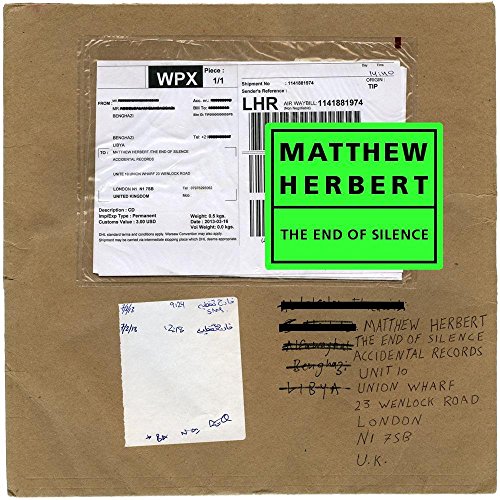
Matthew Herbert
The End of Silence
Release Date: Jun 24, 2013
Genre(s): Electronic, Club/Dance
Record label: EMI
Music Critic Score
How the Music Critic Score works
Album Review: The End of Silence by Matthew Herbert
Great, Based on 6 Critics
Based on rating 4
Just as William Basinski’s landmark Disintegration Loops series will forever be linked with 9/11, Matthew Herbert’s new record, The End Of Silence, will forever be linked to politically motivated violence. Comprised of one five second sample of a pro-Gaddafi plane bombing Libya, Herbert twists, loops, and manipulates the sounds of a siren, crowd chatter, and a bomb exploding with a band in tow to create a disorienting piece, expanding five seconds into almost an hour and making you feel wholly insignificant in the annals of history. On The End Of Silence, Herbert slows down soundwaves to create a piece that sounds chopped up and put back together, one that’s in no way conceptually more complex than a student music project, even if Herbert is dealing with a weighty topic.
Based on rating 75%%
Matthew HerbertThe End of Silence[Accidental; 2013]By Ray Finlayson; August 5, 2013Purchase at: Insound (Vinyl) | Amazon (MP3 & CD) | iTunes | MOGTweetMatthew Herbert loves sounds. In a brief interview with Dummy Magazine, he lists his ten favourite noises that his newly renovated and converted house makes, ranging from the melodical qualities of his toilet bowl, to the scratching of a tree on the roof, to the thud his young son makes when he falls out of bed. It’s a wonderful little insight into the way Herbert’s mind works, hearing music in everything that would otherwise be deemed every day and forgetful by any other person.
Based on rating 7.1/10
Matthew Herbert just took the meticulously reductionist values of his One trilogy and further narrowed his focus. This time around, he zeroes in on a brief moment in time in order to explore his feelings about a single act of terror. The End of Silence uses one 5-second sample as its sole building block, which is contorted and manipulated by Herbert and a three-piece band he put together for this recording.
Based on rating 3.5/5
There’s little new in the argument that it’s exploitative to forge art out of the misery and annihilation of others. We all know the story: a composer, director, or writer coolly appropriates the notoriety and emotional resonance attaching to a particular tragedy or inhumanity, siphons it into her latest work, and simply reclines in her chaise longue in anticipation of the plaudits, while the subjects of her profound “study” either continue to suffer or continue to rot. This shtick is made all the worse by the fact that we — the audiences of such questionable band-wagoning — often use the offending artifacts to perpetuate the self-satisfied lie that we’re compassionate, conscientious, and committed people, when in fact many of us probably spend the time outside of our agony tourism never uttering a word to our neighbors, never offering rides to hitchhikers, and never giving to charity.
Opinion: Excellent
Matthew Herbert really doesn’t like making it easy for himself. Where other electronic musicians rely heavily on the usual instrumentation for their musical compositions, Doctor Rockit looks elsewhere for inspiration: over the years he’s used the sound of manipulated human hair and skin, household objects and the noise of an apple being eaten to make records. The One Club album was created solely from the sounds collected from one night in a German nightclub, while One Pig followed the life cycle of a pig from farm to plate.
Opinion: Very Good
Matthew Herbert’s latest album The End Of Silence uses found sounds to realise a high concept. This fits into his larger body of work, but where before he’s documented domesticity in Around the House, the workings of the internal body (he recorded hair, skin and organs for Bodily Functions), or the life of an animal from farm to kitchen (One Pig), here he deploys the techniques outlined in his manifesto to make a shocking statement on political violence. Herbert uses one five-second audio recording of a pro-Gaddafi plane approaching and dropping a bomb on the northern Libyan town of Ra’s Lanuf, heralded by a brief and futile whistle and warning-cry, as the basis for The End Of Silence, an improvised record patchworked and sequenced into three parts Thick webs of distortion emphasise the undiscriminating nature of the cacophony – and by extension, the attack – as Herbert and his band disintegrate the sample into small pieces that become the instruments of improvisation, the five-second recording extended into a piece of terrifying music.

